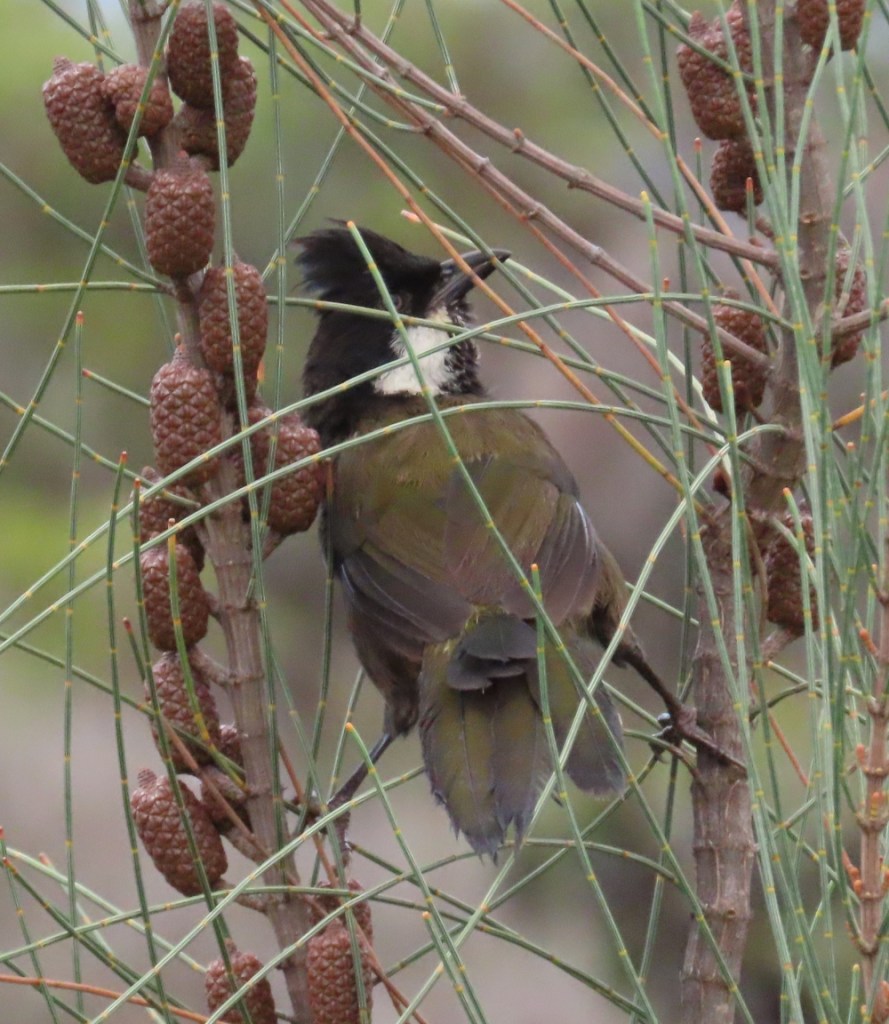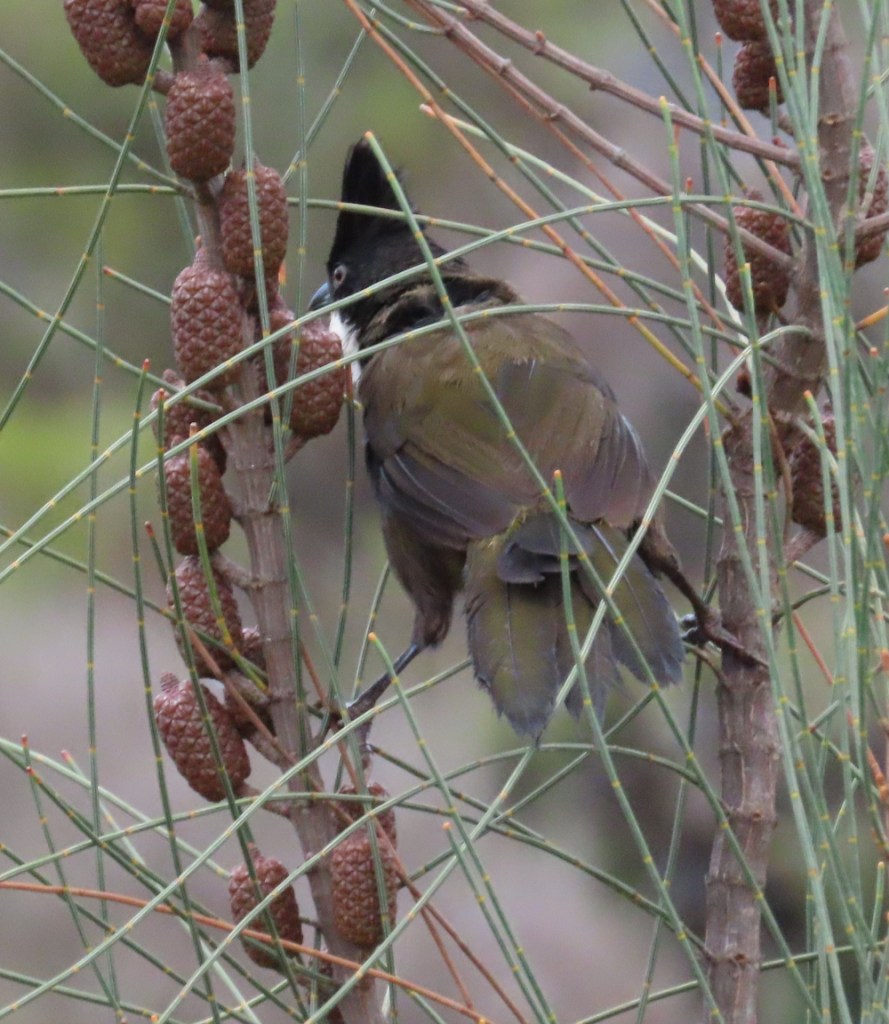Blog Archives
Call of the Whipbird
An Eastern Whipbird does his morning grooming, stopping occasionally to call to his friends. The noise that whipbirds make is strange: “eeeuuw-phwit”. It reminds people of a whip whistling and cracking, and that’s what gives the bird its name.
In the background, you can hear other whipbirds replying. Each time, a bird off-camera echoes the long drawn-out call of the on-camera bird( “eeeuuw-phwit”) then another bird also off-camera replies immediately (“phit-phit-pheeuw”). These two off-camera calls sound like a single call, but they’re actually from two birds.
Common name: Eastern Whipbird
Scientific name: Psophodes olivaceus
Approximate length: 30 cm
Date spotted: 9 March 2025 (summer)
Location: Manly North Head, Sydney Harbour, NSW, Australia: 33°48’55.1″S 151°17’58.9″E
A rather shaggy Whipbird
This little whipbird looks as if it hasn’t combed its feathers in a while. Still, it’s a nice-looking bird. It might be a juvenile, still coming into full feather:


Whipbirds spend their time mostly in the low shrubbery, often rustling around in the leaves on the ground. As a result, they’re hard to spot and they usually look dark brown and black in colour. It’s nice to see one with a bit of sunlight on its feathers, bringing out the soft olive green glow on the wings and tail.
The noise that whipbirds make is strange: “eeeuuw-phwit”. It reminds people of a whip whistling and cracking, and that’s what gives the bird its name. I managed to get a good video of them calling, which I published in an earlier post.
Common name: Eastern Whipbird
Scientific name: Psophodes olivaceus
Approximate length: 30 cm
Date spotted: 16 January 2025 (summer)
Location: Dobroyd Head in Sydney Harbour, NSW, Australia: 33°48’34.0″S 151°16’25.3″E
Three whipbirds calling
The noise that whipbirds make is strange: “eeeuuw-phwit”. It reminds people of a whip whistling and cracking, and that’s what gives the bird its name.
In this video, at least three Eastern Whipbirds are calling to each other. Twice in the video, you can hear two of them doing the long drawn-out whistle at the same time: the whistle vibrates and little. When you hear two (or three) chirps after the whistle and crack, like “eeeuuw-phwit-pheeuw-pheeuw”, the last two (or three) chirps are actually made by a second bird. The final chirps come so close after the first call that it sounds like one bird.
As you can see in the video, whipbirds are very good at hiding in the bushes. It’s hard to get a good picture. They’re quite pretty, in a subdued, forest-loving way.
Here’s one of the birds:

Its head and neck are black and white, with a nice little crest. The back and tail are a soft forest green. Here’s the same bird from a different angle:

Common name: Eastern Whipbird
Scientific name: Psophodes olivaceus
Approximate length: 30 cm
Date spotted: 22 August 2024 (winter)
Location: Dobroyd Head in Sydney Harbour, NSW, Australia: 33°48’35.6″S 151°16’04.6″E
Eastern Whipbird’s dance
Two Eastern Whipbirds were chirruping at each other. One of them did a little dance, puffing up its white cheeks and flaring its wings and tail. Alas, the only photos that I got of the dance are very blurry, but I’ve included them at the end of this post anyway.
This is a good shot of the bird that was dancing:

Eastern Whipbirds are quite reclusive, staying low and using the undergrowth as cover most of the time. It was a pleasure to see one out in the open. They’re pretty in an unobtrusive way, with a black crest on their heads, a grey-black body, white cheek patches, and olive wings and tail.
The other bird was more coy, staying in the bushes and watching its friend:

There’s no difference in plumage between male and female birds. My guess is that the first one is the male, since he was doing the display dance.
The two birds were flitting from place to place, with one of them repeating his little dance at each new location. The dance was so fast that it was hard to see with the naked eye. The photos that I got were alas blurry, but they give some idea of what was happening.
This blurry photo shows a side view of the dancer puffing up its cheeks:

And this one shows a frontal view, with the puffed cheeks and flared wings:

Whipbirds get their name from the long, drawn-out whistle that they make, ending with an abrupt squawk. The call reminds people of a cracking whip, hence the name. You can hear the call in an earlier post.
Common name: Eastern Whipbird
Scientific name: Psophodes olivaceus
Approximate length: 30 cm
Date spotted: 8 March 2024 (summer)
Location: Manly Dam Park near Sydney, NSW, Australia: 33°46’38.7″S 151°14’56.0″E
Whipbird takes a dip in a puddle
This is why they put puddles on paths, right? An Eastern Whipbird enjoys a quick dip in a puddle, on the path right in front of me:
The whipbird is so called because of the rather strange noise it makes: a long drawn-out whistle ending in a small explosion, which reminds people of the crack of a whip. Some of my other posts about this bird manage to capture the sound of the call too.
Common name: Eastern Whipbird
Scientific name: Psophodes olivaceus
Approximate length: 30 cm
Date spotted: 6 November 2021 (spring)
Location: Dobroyd Head Track, Balgowlah Heights, NSW, Australia: 33°48’37.6″S 151°16’23.9″E
Eastern Whipbird chirrups to itself
While foraging and exploring the forest floor, this Eastern Whipbird chattered companionably to itself:
It’s likely that the bird’s partner was nearby. I’ve heard whipbirds chirruping and calling to each other on other occasions too. As well as this quiet chirruping, whipbirds make a long, drawn-out whistle ending in a short explosion. That’s the sound that gives the birds their name. You can hear that call in another post of mine.
Common name: Eastern Whipbird
Scientific name: Psophodes olivaceus
Approximate length: 30 cm
Date spotted: 19 May 2021 (autumn)
Location: Manly Dam Park, New South Wales, Australia: 33°46’48.0″S 151°14’53.6″E
Eastern Whipbirds chatting and pecking at tree
An Eastern Whipbird was busily pecking at a tree, presumably to get at insects or grubs under the bark. Pretty soon, another bird joined the first one. They had an amiable chat. It looked as if they were consulting on how to tackle this troublesome hard bark on the tree. The first bird went back to the task while the other looked on. After a while, the first gave up and the second stepped in to give it a go.
I think the birds are quite young, because their feathers are a little untidy and the white cheek patches aren’t clearly defined. Perhaps they’re siblings!
It was interesting to see the birds interacting and to hear their chatting sounds. I often hear the long drawn-out call that gives these birds their name (this post has some examples) but I haven’t seen them chatting before.
Common name: Eastern Whipbird
Scientific name: Psophodes olivaceus
Approximate length: 30 cm
Date spotted: 15 February 2021 (summer)
Location: Manly Dam Park, New South Wales, Australia: 33°46’44.3″S 151°14’58.8″E
Two varieties of the Eastern Whipbird call
The call of the Eastern Whipbird is a fairly common sound, for those of us lucky enough to live near a patch of Australian bush. The birds make a weird whistling noise that ends in an abrupt burst of noise, a little like the crack of a whip. Hence the name whipbird.
In the first of these two videos, the bird ends its call with an upward tone, while in the second video it chooses a descending tone. First, the upward tone:
Next, the more squeaky downward ending:
The call seems to take a lot of effort, including a little hop and a flap of the wings. I was surprised at how short the bird’s wings are. They seem quite stubby, compared with the elegance of the rest of the body.
Whipbirds are shy, sticking to the undergrowth and making it difficult to get a good picture. Here’s a photo that shows the olive green colouring of the bird’s feathers:
Common name: Eastern Whipbird
Scientific name: Psophodes olivaceus
Approximate length: 30 cm
Date spotted: 3 September 2020 (early spring)
Location: Manly Dam National Reserve, New South Wales, Australia: 33°46’36.2″S 151°14’47.9″E
Call of the whipbird
The birds in Australia make strange noises, and the call of the Eastern Whipbird is one of the strangest.
A sound bite:
Common name: Eastern Whipbird
Scientific name: Psophodes olivaceus
Approximate length: 30 cm
Date spotted: 10 March 2018 (Early autumn)
Location: Manly Dam National Reserve, New South Wales, Australia: 33°46’36.5″S 151°15’16.0″E
Eastern Whipbird nesting, calling, and showing its colours
Eastern Whipbirds make the oddest noise. As their name implies, their call sounds a little like a whip cracking: p-p-peeeuuw pheuw-pheuw. Actually, to me, it sounds more like a laser gun in a child’s science fiction game.
I have two videos to show you. The first is cool because right at the beginning, the bird is in the sun, and you can see all the olive colour in its feathers. Usually, the birds are more like dark blobs because they stick to the shady parts of the bush. In the video you can also see the bird make its characteristic call.
At the beginning of the second video, the bird is tending a nest. I didn’t see that until I got the video home and looked on the wider screen. There’s more of the calling too, which takes a lot of energy. The little bird almost leaps off the branch with the effort.
Common name: Eastern Whipbird
Scientific name: Psophodes olivaceus
Approximate length: 30 cm
Date spotted: 13 August 2017 (Early spring)
Location: Manly Dam National Reserve, New South Wales, Australia: 33°46’36.9″S 151°15’16.7″E



